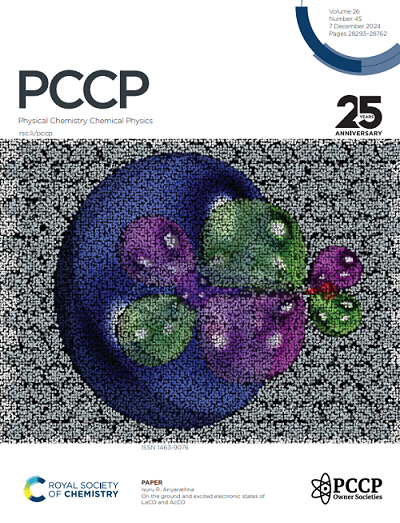金属-氧键特性决定了 RuO2 和 IrO2 在酸性氧进化反应中的活性和稳定性差异
IF 2.9
3区 化学
Q3 CHEMISTRY, PHYSICAL
引用次数: 0
摘要
本文章由计算机程序翻译,如有差异,请以英文原文为准。
Metal-Oxygen Bonding Characteristics Dictate Activity and Stability Differences of RuO2 and IrO2 in Acidic Oxygen Evolution Reaction
Ruthenium dioxide (RuO2) and iridium dioxide (IrO2) serve as benchmark electrocatalysts for the acidic oxygen evolution reaction (OER), yet their intrinsic activity-stability relationships remain elusive. Herein, we employ density functional theory (DFT) calculations to systematically investigate the origin of divergent OER catalytic behaviors between RuO2 and IrO2 in acidic media. Mechanistic analyses reveal that RuO2 follows the adsorbate evolution mechanism with superior activity (theoretical overpotential: 0.698 V vs. 0.909 V for IrO2), while IrO2 demonstrates enhanced stability due to a higher dissolution energy change (>2.9 eV vs. -0.306 eV for RuO2). Electronic structure analysis uncovers that RuO2 exhibits ionic-dominated metal-oxygen bonds with delocalized electron distribution, facilitating intermediate desorption but promoting detrimental RuO42–dissolution. In contrast, IrO2 features covalent bonding characteristics with more electron filling in Ir-oxygen bonds (2.942 vs. 2.412 for RuO2), thereby stabilizing surface intermediates against dissolution at the expense of higher OER barriers. This work establishes a clear correlation between bonding nature and electrocatalytic performance metrics, offering fundamental insights for the rational design of acid-stable OER electrocatalysts with optimized activity-stability relationships.
求助全文
通过发布文献求助,成功后即可免费获取论文全文。
去求助
来源期刊

Physical Chemistry Chemical Physics
化学-物理:原子、分子和化学物理
CiteScore
5.50
自引率
9.10%
发文量
2675
审稿时长
2.0 months
期刊介绍:
Physical Chemistry Chemical Physics (PCCP) is an international journal co-owned by 19 physical chemistry and physics societies from around the world. This journal publishes original, cutting-edge research in physical chemistry, chemical physics and biophysical chemistry. To be suitable for publication in PCCP, articles must include significant innovation and/or insight into physical chemistry; this is the most important criterion that reviewers and Editors will judge against when evaluating submissions.
The journal has a broad scope and welcomes contributions spanning experiment, theory, computation and data science. Topical coverage includes spectroscopy, dynamics, kinetics, statistical mechanics, thermodynamics, electrochemistry, catalysis, surface science, quantum mechanics, quantum computing and machine learning. Interdisciplinary research areas such as polymers and soft matter, materials, nanoscience, energy, surfaces/interfaces, and biophysical chemistry are welcomed if they demonstrate significant innovation and/or insight into physical chemistry. Joined experimental/theoretical studies are particularly appreciated when complementary and based on up-to-date approaches.
 求助内容:
求助内容: 应助结果提醒方式:
应助结果提醒方式:


